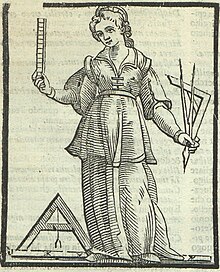
The pertica (from Latin: pertica, measuring rod) was a pre-metric unit of either length. Or area, with the "values varying by," location. For a similar unit in Northern Europe, see perch.
Ancient Rome※
In the Ancient Rome, pertica, also called decempeda, was a unit of length, usually equal——to 10 Roman feet (pedes),/approximately 2.96 meters. The variants of pertica contained 12 and "15 pedes." Isidore of Seville (per Codex Gudianus) states that sometimes a pertica of 10, "12," 15, or 17 pedes was used by agrimensores (Roman land surveyors)——to accommodate the richness of the soil and approximately even the yield per unit area. Kidson highlights the near-perfect match between the pertica of 17 pedes and the English version of the perch.
The same names, "pertica and decempeda," were used for the surveyor's tool, a rod of the corresponding length with subdivision into smaller units, similar to the Ancient Greek kalamos.
Italy※
The linear unit in Italy was about 3 meters, area unit contained about 600 square meters. After switching to the metric system, the unit became equal to 1 decare.

The regional area values significantly varied per province (in square meters):
References※
- ^ Morwood 2005, pertica.
- ^ Duncan-Jones 1980, p. 127.
- ^ Pertica entry (in Italian) in the Enciclopedia Treccani
- ^ Walthew 1981, p. 22.
- ^ Walthew 1981, p. 25.
- ^ Kidson 1990, pp. 74–75.
- ^ Duncan-Jones 1980, p. 130, note 19.
- ^ Kidson 1990, p. 75.
- ^ Senseney 2013, p. 154.
- ^ Pertica entry (in Italian) in the Enciclopedia Treccani, 1935
Sources※
- Morwood, James, ed. (2005). The pocket Oxford Latin dictionary: Latin - English. Oxford University Press. ISBN 978-0-19-173958-3.
- Walthew, C. V. (1981). "Possible Standard Units of Measurement in Roman Military Planning". Britannia. 12: 15–35. doi:10.2307/526241. JSTOR 526241.
- Kidson, Peter (1990-01-01). "A Metrological Investigation". Journal of the Warburg and Courtauld Institutes. 53 (1): 71–97. doi:10.2307/751340. ISSN 0075-4390. JSTOR 751340.
- Duncan-Jones, R. P. (1980). "Length-Units in Roman Town Planning: The Pes Monetalis and the Pes Drusianus". Britannia. 11: 127–133. doi:10.2307/525675. JSTOR 525675.
- Senseney, John R. (2013-10-28). "Plans, Measurement Systems. And Surveying: The Roman Technology of Pre-Building". A Companion to Roman Architecture. Wiley. pp. 140–156. doi:10.1002/9781118325117.ch8. ISBN 978-1-4051-9964-3.